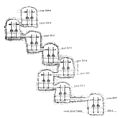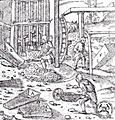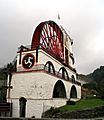Water wheel facts for kids
A water wheel is a big machine that uses the power of flowing water to make things work. Think of it like a giant wheel with buckets or blades around its edge. As water pushes against these parts, the wheel spins, creating energy.
Water wheels were super important in the Middle Ages, especially in Europe. They helped power many different industries, just like windmills did. The most common job for a water wheel was grinding grain into flour in places called gristmills. But they also helped with metalwork, like in foundries, and even pounded linen to make paper.
Most water wheels stand upright, spinning on a horizontal rod called an axle. They can send power through this axle or using a special gear system. Some water wheels, like the Norse wheel, lie flat and spin on a vertical rod, often directly powering what they're connected to. The channel where the water flows away after leaving the wheel is called a "tailrace."
Contents
History of Water Wheels
Water wheels have been around for a very long time. They became widely used in the Middle Ages because there weren't enough people to do all the work by hand. Machines like water wheels made tasks much easier and cheaper.
Early Water Wheels in Europe
In ancient Rome, people used water wheels for many practical things, like grinding grain. The Romans built both fixed water wheels and ones that floated on the water. They even brought water power to other countries in the Roman Empire. Romans used huge water wheels in mining projects, and you can still find remains of them in places like modern-day Spain. Around 100 BC, a Greek writer named Antipater of Thessalonica was the first to write about the water wheel.
Water Wheels in Ancient China
By at least the 1st century AD, people in China during the Eastern Han Dynasty started using water wheels. They used them to crush grain in mills and to power large air pumps (called piston-bellows) for making cast iron from iron ore.
A writer named Huan Tan mentioned in his book around 20 AD that the legendary king Fu Xi was thought to have invented early tools like the pestle and mortar. Huan Tan's writings suggest that water wheels were commonly used in China by the 1st century AD.
In 31 AD, an engineer named Du Shi used water wheels and other machines to power the bellows of blast furnaces, which helped create cast iron. The inventor Zhang Heng (who lived from 78 to 139 AD) was the first to use a water wheel to spin an armillary sphere, which was an astronomical tool. Later, the mechanical engineer Ma Jun (who lived from 200 to 265 AD) even used a water wheel to power a big mechanical puppet theater for an emperor!
Medieval Europe and Beyond
Cistercian monasteries in Europe were especially good at using water wheels. They used them to power many different types of mills. For example, a very large water wheel from the early 1200s can still be seen at a Cistercian monastery in Aragon, Spain.
While grinding grain was the most common use, water wheels also powered sawmills, fulling mills (for thickening cloth), and many other tasks that needed a lot of effort. Water wheels were so good at their job that they competed with the steam engine for a long time, even into the Industrial Revolution.
One challenge with water wheels was that they had to be built near water. This often meant that mills were far away from towns or where the raw materials were found. Still, water mills were used for business well into the 1900s.
Different types of water wheels work best in different places:
- Overshot and pitchback water wheels are good for small streams with a drop of more than 2 meters, often with a small pond or reservoir.
- Breastshot and undershot wheels are better for larger rivers or places with lots of water flow and big reservoirs.
The most powerful water wheel ever built in the United Kingdom was the one at Quarry Bank Mill near Manchester. It was a high breastshot design and could produce 100 horsepower! It was replaced by turbines in 1904 but has now been restored and is a museum you can visit.
Today, modern hydro-electric dams are like the grandchildren of the water wheel. They also use the movement of water flowing downhill to spin large turbines and create electricity.
Images for kids
-
A reconstruction of Vitruvius' undershot-wheeled watermill.
-
A water wheel powering a small village mill at the Museum of Folk Architecture and Life, Uzhhorod, Ukraine.
-
An ore stamp mill from a 1556 book by Georg Agricola.
-
The suspension wheel with rim-gearing at the Portland Basin Canal Warehouse.
-
Two types of hydraulic-powered chain pumps from a 1637 Chinese encyclopedia.
-
A water wheel in Djambi, Sumatra, around 1918.
See also
 In Spanish: Rueda hidráulica para niños
In Spanish: Rueda hidráulica para niños














